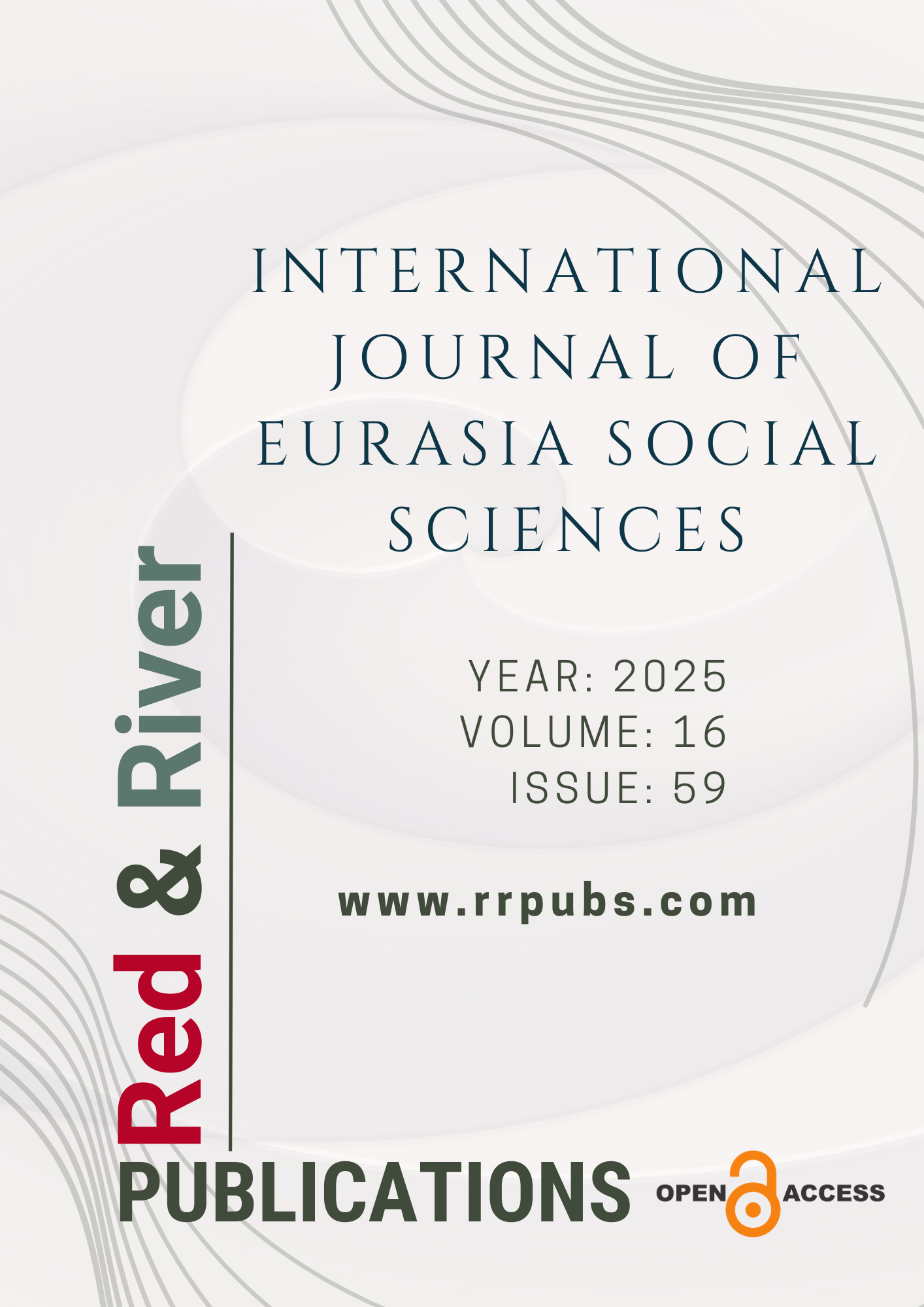Looking at the “absence of home” in contemporary art through the trace of memory
DOI:
https://doi.org/10.70736/ijoess.568Keywords:
Contemporary art, home, absence of home, social memoryAbstract
The theme of home is a frequently encountered subject in the history of art. The views of houses in artworks gain diversity with landscapes including interior and exterior spaces or symbolic-metaphorical expressions. In contemporary art, it is particularly noteworthy that houses are among the working subjects of artists with their dimension based on extinction. Situations such as the change of social order in contemporary life, transformation of living conditions, globalisation, belonging-not belonging due to migration and displacement, social inequality have prepared the ground for questioning the presence and absence of the house. This research aims to examine the art practices of artists working on the absence of home in contemporary art. By selecting a work by Petrit Halilaj, Rachel Whiteread, Christian Boltanski and Doris Salcedo, the meanings between memory traces and ‘the presence and absence of home’ were evaluated and multiple layers of meaning were emphasised. These works, which express the ‘absence of home’, are analysed in terms of the relationships established with memory and memories and the characteristics of reminder space. This research shows that artists create spaces that embody the ‘absence of home’ through memory based on individual and social experiences or use existing spaces in the context of disappearing homes. While these artists establish a connection between the ‘absence of home’ and memory in their works, they use indirect reflection methods that prevent the establishment of a direct relationship. Although the works of the artists function as memory spaces for memories of home, they also offer a way for viewers to question and reflect.
References
Arnheim, R. (2012). Görsel düşünme, Metis.
Artun, A., Ojalvo, R. (2012). Arzu Mimarlığı, Mimarlığı düşünmek ve düşlemek, İçinde Nilüfer Talu, Sanatın konusu olarak ev, İletişim.
Barlas, M. (2019). Çağdaş sanatta nesne mekân olarak ev imgesi, Sanat ve Tasarım Dergisi, 95-109.
Bachelard, G. (2023). Mekânın poetikası, Çev:Alp Tümertekin, Minotor.
Beltrán, V. G., Restrepo, S. (2015). Doris Salcedo: Creadora de memoria. Nómadas, (42), 185-193.
Boltanski, C. (1990). Kayıp ev [Özgün Eser], Berlin. https://flash---art.com/article/christian-boltanski/
Certeau, M. D. (2008). Gündelik hayatın keşfi-1. Dost.
Chan, T.F. (2022). Petrit Halilaj Tate St Ives'te travma ve umut üzerine düşünüyor, Erişim Tarihi: 12.03.2024, https://www.wallpaper.com/art/petrit-halilaj-interview-2021-tate-st-
Cohen, A. (2018). Whiteread’in “Ev”i yaşanmaz, tartışmalı ve unutulmazdı, https://www.artsy.net/article/artsy-editorial-rachel-whitereads-house-unlivable-controversial-unforgettable
Dewey, J. (2021). Deneyim olarak sanat. VakıfBank Kültür.
Halbwachs, M. (2018). Kolektif bellek. Çev: Zuhal Karagöz, Pinhan.
Haladyn, J. J. (2009). The missing house, Published in On Site Review 22, War, 59.
Halilaj, P. (2010). Aradığım yerler, canım, ütopik yerler, sıkıcı ve onları nasıl gerçeğe dönüştüreceğimi bilmiyorum, [Enstalasyon Görünümü], 6. Berlin Bienali. https://www.wallpaper.com/art/petrit-halilaj-interview-2021-tate-st-ives
Harvey, D. (2019). Postmodernliğin durumu, Metis.
Huyysen, A. (2003). Present pasts: Urban palimsests and the politics of memory, Standford: Stanford University.
Gibbsons, J. (2007). Contemporary art and memory, New York: I.B.Tauris & Co Ltd.
Lauzon, C. (2017). The unmaking of home in contemporaray art, London: University of Toronto Press.
Gür, N. (2020). “Eran Shakine, Jason Rhoades, Hale Tenger ve Rachel Whiteread’in yapıtlarında geçmişin envanteri: Ev”, Ulakbilge, 53, 1170-1178. http://doi.org/10.7816/ulakbilge-08-53-07
Lefevbre, H. (2020). Gündelik hayatın eleştirisi I, 5. Baskı, Sel.
Loginova, M.V. & Prokhorova, N.I. (2022). Transformations and interpretations of the concept of “home” in contemporary art, Herald Culturology Journal, 1, 165-177, http://doi.org/10.31249/hoc/2022.01.08
Moran, B. (2008). Edebiyat kuramları ve eleştiri, İletişim.
Nora, P. (2006). Hafıza mekânları, Çev: M. Emin Özcan, Dost.
Richards, K. M. (2014). Yeni bir bakışla Derrida, Çev: Zeynep Talay, Berdan.
Saybaşılı, N. (2017). Sanat sahada, Görsel kültür çalışmalarında etnografik bilgi, Metis.
Salcedo, D. (2003). İsimsiz [Enstalasyon], yakl.10,1×6,1×6,1m, https://publicdelivery.org/doris-salcedo-chairs/
Solomon-Godeau, A. (1998). Mourning or melancholia: Christian Boltaski’s “Missing house”, Oxford Art Journal, 21 (2) 1-20. https://doi.org/10.1093/oxartj/21.2.1
Sotelo, M., L., R. (2004). Doris Salcedo: Challenging history and memory, Master in Arts, University of Pittsburgh.
Özdemir, U. (2010). Evsizlik ve evsizlere genel bir bakış. Toplum ve Sosyal Hizmet, 21(2).
Özkan, Ö., Öz, O. (2023). Christian Boltanski’nin sanatında ölümden arda kalanlar: Anıt, Arşiv ve Hafıza, Sanat Yazıları, (49), 495-510. https://doi.org/10.61742/sanatyazilari.1318044
Perry, G. (2014). Playing at home: The house in contemporary art, Reaktion Books, Limited, Pro Quest Ebook Central.http://ebookcentral.proquest.com/lib/anadolu/detail.action?docID=1803088.Created from anadolu on 2023-04-29 11:19:43.
Public Delivery (2024). Doris Salcedo’nun etkileyici sandalye enstalasyonu, Erişim Tarihi:12.03.2024, https://publicdelivery.org/doris-salcedo-chairs/
Türk Dil Kurumu (t.y). Türk dil kurumu sözlüğü, Erişim Tarihi:02.02.2024, https://sozluk.gov.tr/
Yüksel, H. N., & Cihaner Keser, S. (2022). Çağdaş sanatta mekân olarak evin katmanları, SDÜ Art-E Güzel Sanatlar Fakültesi Dergisi, 15 (29). https://doi.org/10.21602/sduarte.1080543
Whiteread, R. (1993). “Ev”, 193 Grove road, [Özgün Eser], Londra. https://www.artsy.net/article/artsy-editorial-rachel-whitereads-house-unlivable-controversial-unforgettable
Wikipedia (t.y). Ev (Heykel), Erişim Tarihi: 12.03.2024 https://en.wikipedia.org/wiki/House_(sculpture)
Downloads
Published
How to Cite
Issue
Section
License
Copyright (c) 2025 Bahar Karaman Guvenc

This work is licensed under a Creative Commons Attribution 4.0 International License.

